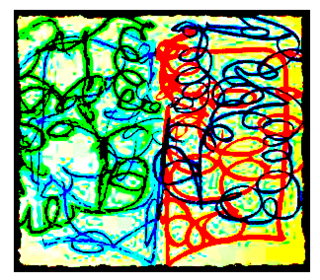
Bilateral Drawing.
Supply: © 2015 Cathy Malchiodi, Ph.D.
Bilateral Stimulation (BLS) is a broadly used strategy in lots of present methods to handle trauma. It’s present in practices like Eye Motion Desensitization and Reprocessing (EMDR) and varied types of tapping and sensory integration strategies. Sensorimotor purposes of expressive arts remedy complement BLS and incorporate developmental, brain-wise, and body-based ideas from up to date and revolutionary trauma therapies. In distinction to protocols like Sensorimotor Psychotherapy® (SP) that focuses on speaking about physique consciousness, expressive arts approaches worth implicit communication—the nonverbal expressions that talk the physique’s expertise of menace in addition to security.
As I’ve famous in earlier posts, bilateral work merely means “involving two sides.” Sensory integration is commonly related to bilateral strategies that help people in organizing particular sensations through strategies generally present in occupational remedy. Within the technique of reparation from psychological trauma, varied types of bilateral stimulation or motion appear to be efficient in participating cross-hemisphere exercise within the mind, similar to Francine Shapiro’s discovery of a watch motion protocol that finally got here to be often known as EMDR (Eye Motion Desensitization and Reprocessing (Shapiro, 2001). In expressive arts remedy, bilateral motion, drawing, self-tapping, or listening to sounds could be a part of sensory-based psychotherapeutic experiences (Malchiodi, 2011/2020). Most of these purposes appear to have an affect on restoration from traumatic occasions as a result of for a lot of people, the limbic system and proper hemisphere of the mind are hyperactivated by precise experiences or recollections of trauma. Whereas not utterly understood, particular processes present in bilateral stimulation might assist regulate physique and thoughts thus permitting express memory to be reconnected with implicit reminiscence.
Bilateral drawing is a deceptively easy art-based exercise that has been round since at the very least the Fifties that capitalizes on self-regulating properties just like rocking, strolling, biking, or drumming. Some practitioners check with bilateral drawing as “scribbling with each arms” as a result of the intent will not be essentially to make a selected picture, however to as a substitute simply have interaction each arms in spontaneous drawing with chalks, pastels, or different simply manipulated artwork supplies. Like many artwork and expressive arts therapists, I’ve used this exercise for a number of many years and truly realized it throughout faculty artwork programs as a manner of “loosening up” earlier than starting to attract or paint (see movie beneath).
Florence Cane (1951) is certainly one of many early practitioners who noticed a connection between free-form gestural drawing on paper, the kinesthetic sense concerned in motion, and the embodied qualities of the expertise. In her work with youngsters and adults within the mid-Twentieth century, Cane hypothesized that it is very important have interaction people by means of actions that transcend using the arms to have interaction the entire physique in pure rhythms. Specifically, she refers to massive swinging gestures that come from the shoulder, elbow, or wrist to not solely liberate inventive expression, but in addition act in a restorative capability to assist wholesome rhythms within the physique and thoughts. In different phrases, these rhythmic actions could be practiced within the air after which later transferring them to paper with drawing supplies.
Therapists echo Cane’s observations in medical purposes of expressive artwork with people, utilizing a number of variations of the easy scribble in circumstances of trauma and bilateral drawing strategies (McNamee, 2003) for not solely self-regulation, but in addition in trauma processing (Malchiodi, 2020; Urhausen, 2015). Within the case of bilateral drawing, there’s an assumption that as a result of each arms are engaged that each hemispheres of the mind are stimulated. When mixed with trauma narratives, it’s believed that visible, auditory, or tactile cues assist the person by directing give attention to the current fairly than what has occurred previously.
Functions of bilateral expressive arts appear to be efficient, however most of those arts-based purposes haven’t been completely defined and solely exhibit preliminary effectiveness by means of small scale observational research and case examples. Finally, we might discover out that making marks or gestures with each arms concurrently creates an attention shift away from the distressing sensations within the physique to a distinct, action-oriented, and self-empowered focus. Till we all know extra, get pleasure from this brief movie presentation introducing bilateral work.
Source link













